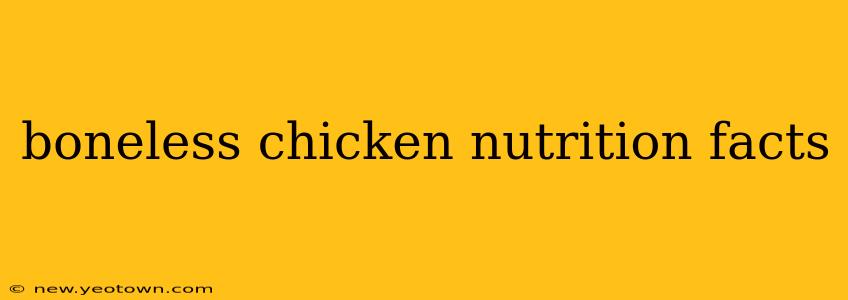The humble boneless, skinless chicken breast. It's a staple in kitchens worldwide, a lean protein source lauded for its versatility and health benefits. But beyond its culinary appeal lies a nutritional profile that deserves a closer look. This isn't just about calories; it's about understanding the rich tapestry of vitamins, minerals, and macronutrients that make this poultry powerhouse so beneficial. Let's dive into the details, exploring why it's a cornerstone of healthy diets.
What are the nutritional benefits of boneless, skinless chicken breast?
Boneless, skinless chicken breast is remarkably low in fat, particularly saturated fat, making it a fantastic choice for those watching their cholesterol levels. Imagine this: you're enjoying a delicious, protein-packed meal without the guilt of excessive fat intake. This low-fat profile contributes significantly to maintaining a healthy weight and reducing the risk of heart disease. But the benefits don't stop there. It's a treasure trove of essential vitamins and minerals crucial for bodily functions. We're talking about niacin, vitamin B6, selenium – all players in maintaining energy levels, supporting immune function, and contributing to overall well-being.
How many calories are in a boneless, skinless chicken breast?
The calorie count in a boneless, skinless chicken breast can vary slightly depending on the size of the breast. However, a typical 3-ounce serving (about the size of a deck of cards) usually contains around 140-160 calories. This relatively low calorie count, combined with its high protein content, makes it an ideal choice for weight management strategies. Remember that cooking methods can subtly impact the final calorie count, but the differences are usually minimal.
Is boneless, skinless chicken breast good for weight loss?
Absolutely! The combination of high protein and low fat makes boneless, skinless chicken breast a weight-loss champion. Protein keeps you feeling full and satisfied for longer, reducing cravings and preventing overeating. This satiety effect is crucial for successful weight management. Furthermore, the body burns more calories digesting protein than it does carbohydrates or fats, leading to a slight metabolic boost. This means that your body works a little harder just processing this healthy protein source. So, if you're aiming for a healthier weight, include this lean protein in your diet plan!
How much protein is in a boneless, skinless chicken breast?
A 3-ounce serving of boneless, skinless chicken breast packs a powerful punch of protein, boasting roughly 26-30 grams. Protein is the building block of muscles, tissues, and enzymes, vital for growth, repair, and overall bodily function. Sufficient protein intake is crucial for maintaining muscle mass, particularly important as we age. This makes chicken breast an excellent choice for athletes, active individuals, and anyone aiming to maintain strong, healthy muscles.
What are the potential downsides of eating too much boneless, skinless chicken breast?
While generally healthy, over-reliance on any single food source can lead to nutritional imbalances. Consuming too much chicken breast might mean neglecting other vital nutrients found in diverse food groups. Variety is key! A well-balanced diet that includes fruits, vegetables, whole grains, and other protein sources is crucial for optimal health. Moreover, while low in fat, excessive consumption of any protein can put a strain on the kidneys. Always strive for moderation and balance in your diet.
Conclusion: A Nutritional Champion
The boneless, skinless chicken breast deserves its place as a nutritional superstar. Its impressive protein content, low-fat profile, and rich vitamin and mineral composition make it a cornerstone of healthy eating. While moderation and dietary diversity are crucial, incorporating this lean protein into a balanced diet can contribute significantly to your overall health and well-being. Remember, consulting a registered dietitian or nutritionist can provide personalized guidance tailored to your individual needs and goals.

